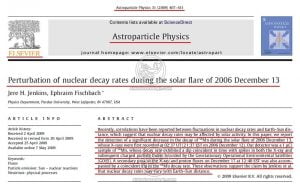In the Name of God
Hypothesis of Evolution- Forbidden Area!!!- 4

A pretext called fossils!!!
In the previous section of the paper, we found for many reasons that the hypothesis of evolution was, at best, only a hypothesis because it lacked accurate and reliable documentation to cover all of its dimensions, and it is by no means eligible for theory, reality or law!
However, proponents of the hypothesis of evolution have relied on some information in the fields of geology, paleontology, biochemistry, genetics, molecular biology and so on to make your claim completely scientific, and they take advantage for confirmation of their claim.
Examples include Stanley Miller test, Fossils, population studies on the Y chromosome and mitochondrial DNA, study on the genetic and proteomic structure of different proteins and drawing phylogenetic trees for them, citing the problem antibiotic resistance of bacteria and so on that will be discussed in detail from now on.
A pretext called fossils- Part I
What information do fossils provide us with?
If we take a look at the books, papers, and films of proponents of the hypothesis of evolution, we will see that important parts of them are material based on fossils. This is especially true of books, papers and films presented to a general audience, and it is observed that in books, papers, and films related to the general audience, because of the simpler reasoning of fossils, as well as the credibility of the issue, have become more focused on such arguments.
Throughout the hypothesis of evolution books, both public and specialized, are filled with images based on some fossils and, of course, with the art of loving evolutionary artists, and they provide images of bones, fossils as well as supposedly reconstructed images of prehistoric living creatures, especially some of the artistically reconstructed images that enhance the audience’s credibility! The following images are a part of these examples:


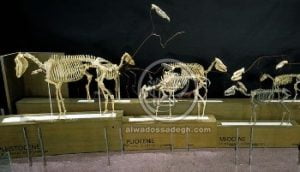
Horse sequences that, based on some skeletal features, show the evolution of horses as claimed by proponents of the hypothesis of evolution (In future papers, this claim will be discussed in detail and the problems contained therein will be discussed).
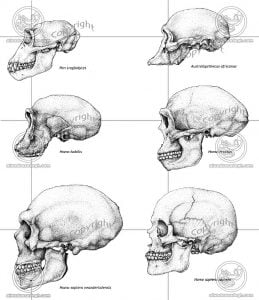

Sequences of skulls, which represent the path of human evolution as claimed by the proponents of the hypothesis of evolution (In future papers, this claim will be discussed in detail and the problems contained therein will be discussed).


The reconstructed skulls and images attributed to the Homo Erectus which provided by proponents of the hypothesis of evolution (In future papers, this claim will be discussed in detail and the problems contained therein will be discussed).



The reconstructed skulls and images attributed to the Homo Habilis which provided by proponents of the hypothesis of evolution (In future papers, this claim will be discussed in detail and the problems contained therein will be discussed).
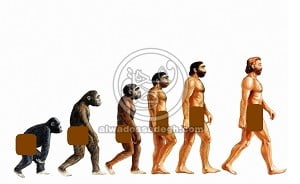
Reconstructed images of the path of the human evolution that illustrates the evolutionary process of humanity as claimed by the proponents of the hypothesis of evolution (In future papers, this claim will be discussed in detail and the problems contained therein will be discussed).
As you have seen briefly, the proponents of the hypothesis of evolution have been heavily insisting on and investing in their claimed fossils and have used them to confirm their claims. And in the meantime, these fossils have been used most to convince their general audience! In this regard, if we look at the books, papers and films of proponents of the hypothesis of evolution, we will find that from their point of view, the fossils claimed by them contain solid and precious information, as well as solid evidence to confirm of the hypothesis of evolution, so on the basis of these fossils, the proponents of the hypothesis of evolution raise numerous debates about the physical forces, social relationships, reproduction, and so on of these creatures! And in the meantime they do storytelling!!!
But do fossils, as evolutionists claim, provide much information about these living creatures, their physical condition, their physiological conditions, and even the time they live? Are fossils as accurate mirrors of the life situation of prehistoric creatures?
In short, it should be said no! Fossils do not provide much accurate information about their living creatures!!! Fossils are not a good mirror of physiological conditions, genetic status, fertility and even the life of living creatures.
This may be a bit strange at first and may be different from what we have mostly heard in the media, but there are a number of reasons for mistrust of fossil information, which we point them in this paper and some future papers.
Serious bugs, ambiguities, and criticisms of the fossil records lifetime
Contrary to evolutionists’ claims that they provide a relatively accurate range for living fossil records, for example, that the fossils lived about 2.3 to 2.5 million years ago, scientifically, there are many challenges and ambiguities for times claimed.
Most of the methods used to calculate the lifetime of the fossil records are based on radiometric dating (1) but what is Radiometric dating?
The basis of the radiometric dating is based on the reactions of the radioactive decay (2). For a better understanding of this issue, please refer to the following explanation (3):
The nucleus of radioactive atoms are the unstable nucleus of some elements that, over time, through some reactions called Radioactive decay (including alpha, beta and gamma decays) and through losing some of their inner energy becomes the nucleus of more stable atoms. For example, the unstable nucleus of the 238U atom over time, as a result of the radioactive decay reaction, becomes the more stable nucleus of the 234Th atom. Another example is the conversion of the unstable nucleus of the 14C atom to the stable nucleus of the 14N atom during the radioactive decay reaction (4):
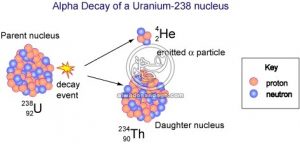
Radioactive decay: In which the unstable nucleus of the 238U atom becomes over time the more stable nucleus of the 234Th atom.
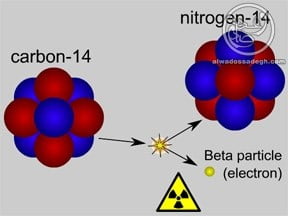
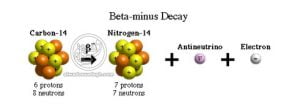
Radioactive decay: In which the unstable nucleus of the 14C atom becomes over time the more stable nucleus of the 14N atom.
In many cases, however, it is not just a Radioactive decay reaction, but a chain of successive Radioactive decay reactions that make the most unstable to the most stable nucleus. For example, the unstable nucleus of the 212Pb atom becomes more stable of the 208Pb atom over time through several successive Radioactive decay reactions (5). Another example is the conversion of the unstable nucleus of the 131Sn atom over time by several successive Radioactive decay reactions to the more stable nucleus of the 131Xe atom (6).
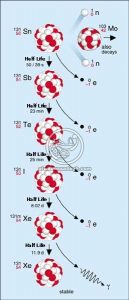
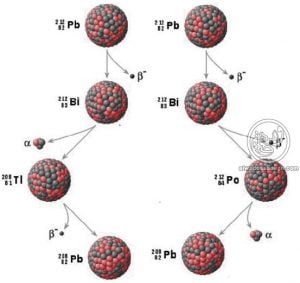
A chain of successive Radioactive decay reactions that make the most unstable nucleus to the most stable nucleus: In the right image, the unstable nucleus of 212Pb atom over time and at the effect of several successive Radioactive decay reactions results in a more stable nucleus of the 208Pb atom. In the left image, the unstable nucleus of the 131Sn atom becomes more stable nucleus of the 131Xe over time through several successive Radioactive decay reactions.
These radioactive decay reactions cause the number of early unstable nucleus called Parent Nucleus to become Daughter Nucleus over time. Thus, in a sample containing radioactive elements, the number of parent nucleus was reduced over time and added to the number of Daughter Nucleus (7):
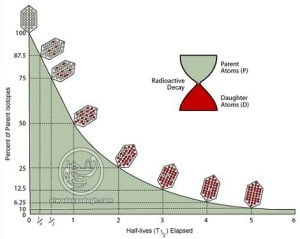
As shown in the images above, in a sample containing radioactive elements, the number of parent nucleus reduced over time and the number of Daughter Nucleus increased (Gray dots indicate Parent Nucleus and red dots indicate Daughter Nucleus)
This process of converting Parent Nucleus to Daughter Nucleus in radioactive materials forms the basis of radiometric dating (8). Radiometric dating method is based on the following assumptions (9):
1) In a radioactive sample, 1.2 (one-second) unstable nucleus, called Parent Nucleus Cells, during a specific time, called half-life (t½) tolerate Radioactive decay and become Daughter Nucleus.
2) (t½) is a constant and known time for any Radioactive decay reaction (Scientists favor the use of the radiometric dating method assume this way). According to this assumption, the conversion time of 235Ur to 207Pb is about 707 million years, and the conversion time of 14C to 14N is about 5730 years. The following table shows (t½) of some of the most important Radioactive decays (10):
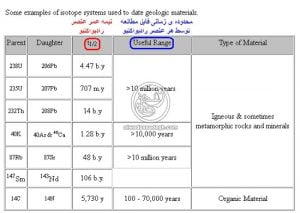
3) According to assumption and proponents of radiometric dating, (t½), for any reaction of radioactive decay, is a constant time, does not have influenced by other factors. It is also assumed that (t½) remains constant over time.
4) In the radioactive sample studied, there was no Daughter Nucleus at the elementary time (zero hour) and all samples contained only Parent Nucleus.
5) Assuming (t½), this time is a Radioactive decay reaction on the one hand, assuming this time remains constant over the centuries and ages, based on the ratio between Parent Nucleus and Daughter Nucleus can be understood to have some half-lives have been elapsed since elementary time (zero hour).
6) Between Parent nucleus at (zero hour), Parent Nucleus after time, (t½), and radioactive sample life, the simplified formula below is governed:
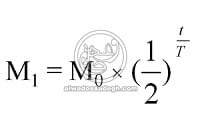
M0: Parent Nucleus value at zero hour.
M1: Parent Nucleus value after time t.
t: Time elapsed from zero hour.
T: Half-life of radioactive element of M.
By specifying (t½) time and the ratio between Parent Nucleus and Daughter Nucleus at the time of study, the time elapsed since the start of the radioactive decay was obtained by the above assumptions, which is equivalent to the life of the radioactive material in question, but the formula must be logarithmically changed for this purpose.
7) All of the above is true when the studied system is a closed system, meaning no Parent Nucleus radioactive material is not entered from the out of system, and no radioactive material of Daughters Nucleus do not get out of the system. That is, changing the parent and daughter nucleus concentration in the studied sample should only be by Radioactive decay reactions and there should be no reason to increase or decrease the parent and daughter nucleus other than the above method.
The summary of the above assumptions are shown in the following images (11):
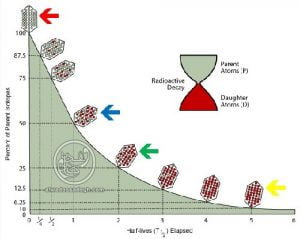
As shown in the images above, in a sample containing radioactive elements, the number of parent nucleus reduced over time and the number of Daughter Nucleus increased (Gray dots indicate Parent Nucleus and red dots indicate Daughter Nucleus). Based on the ratio between Parent Nucleus and Daughter Nucleus, one can be estimated from the approximate elapsed life of the early moment (zero hour) located to the left of the image. The red arrow indicates the material studied at zero hour in which all Parent Nucleus nucleus are visible and no daughter nucleus. The blue arrow refers to the material studied after one half-life. In this case, half of the nucleus are Parent Nucleus and the other half are Daughter Nucleus. The green arrow indicates the material studied after 2 half-lives. In this situation, one-fourth of the nucleus are Parent Nucleus and the other three-fourth are Daughter Nucleus. The yellow arrow indicates the material studied after 5 half-lives. In this situation, only about 3% of the nucleus are Parent Nucleus and the other 97% are Daughter Nucleus.
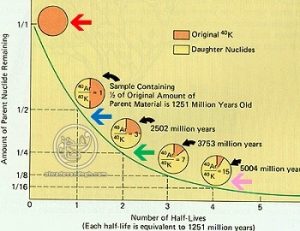
A practical example of the use of the radiometric dating method in converting the radioactive element is the conversion of 40K to 40Ar, which is also of interest to geologists and paleontologists. An example containing 100% nucleus of the radioactive element is 40K atom. Red arrow, over time, decays and becomes a more stable nucleus of 40 Ar. Since the half-life of the radioactive decay reaction during which the 40K is converted to 40Ar is about 1251 million years, with a obe half-life (1×1251=1251) (blue arrow), only 50% of the sample is composed of 40K and 50% is composed of 40Ar. After 2 half-lives (2×1251=2502 million years) (green arrow), only 25% of the sample is composed of 40K and 75% is composed of 40Ar. After 4 half-lives (4×1251=5004 million years) (pink flash), only 6% of the sample is composed of K40 and 94% is composed of 40Ar. On the other hand, similarly, considering the relationship between the parent nucleation ratio of 40K and the daughter nucleus of 40Ar in the sample containing 40K and 40Ar and by considering the half-life of the radioactive decay of 40K, the half-life of sample containg above mentioned elements can be calculated.
According to the above, geologists, paleontologists and biologists use the 14C atom present in bones and fossils to examine the life of living organisms in the time span of less than 70000 years ago (12). But in the many cases, 238Ur, 235Ur, 87Rb, 40K and so on in the geological layers adjacent of the recored fossil (mainly layers of igneous rocks) is the base of the lifetime assessment of these fossils (13). Because the aforementioned elements, although not sufficiently in vivo, due to the abundance of the aforementioned elements in the igneous layers adjacent to the sedimentary layers containing the fossils, as well as the long half-life of the aforementioned radioactive elements in the order of several billion, have superior to 14C for studies of longer time intervals and can also be studied for periods of up to several billion years (14). The following table shows the half-life and time intervals studied by some of the radioactive elements used in the fields of geology, paleontology and biology (15):
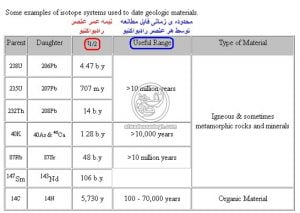

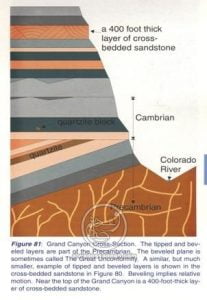
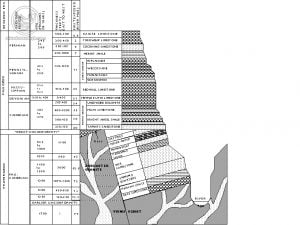

The Grand Canyon are of the United States (note the different layers of rock in this area); based on dating methods, most of which are based on radiometric dating, the rocky layers of the area have been attributed to different geological times. Paleontologists find fossils in these rock layers similar to those of the nearby rocks. Similar method was used to estimate the lifetime of fossil records in other area, the fossils record in each layer are timed and estimated based on the radiometric dating of the adjacent layers of the radioactive element.
In short, many proponents of the hypothesis of evolution use the radiometric dating method to estimate the time of the fossil record and to schedule the fossils based on the time taken. Given the primacy of these times, they expnad their theories.
As mentioned, the radiometric dating method used in biology is based on the half-life of radioactive decay of the radioactive elements in the fossils or rocks adjacent to the fossils. This dating method is based on major assumptions (16):
1) Unstable radioactive elements, over time, find more stable, Radioactive decay, which occurs at certain times called the half-life. With each half-life, the amount of radioactive unstable element reaches half that of the previous one.
2) The half-life of the radioactive decay is constant over time.
3) The half-life of radioactive decay is not related to environmental factors.
4) In the studied radioactive sample, there was no Daughter Nucleus at elementary time (zero hour), and all samples contained only Parent Nucleus.
5) Assuming (t½), this time is a Radioactive decay reaction on the one hand, assuming this time remains constant over the centuries and ages, based on the ratio between Parent Nucleus and Daughter Nucleus can be understood to have some half-lives have been elapsed since elementary time (zero hour).
6) All of the above is true when the studied system is a closed system, meaning no Parent Nucleus radioactive material is not entered from the out of system, and no radioactive material of Daughters Nucleus do not get out of the system. That is, changing the parent and daughter nucleus concentration in the studied sample should only be by Radioactive decay reactions and there should be no reason to increase or decrease the parent and daughter nucleus other than the above method.
So far, everything seems to be scientifically accurate and it is thought that radiometric dating is a very accurate and perfect method for studying fossils!
But is this true about Radiometric dating? Is it an accurate and perfect method, as proponents of the hypothesis of evolution claim? Are the times that evolutionists claim about fossil correct and reliable?
In short, it should be said no!!! Proponents of the hypothesis of evolution claim that the radiometric dating method is flawless is an overstatement. According to research and studies in this field, the accuracy and capability of relying on the radiometric dating method face many important challenges, ambiguities and criticisms!
Interestingly, despite the serious challenges to the radiometric dating method, and in particular its applications to geology and paleontology, papers published in this field, despite being published in valid publications, faced with the silence and adulation of evolutionists, which suggests another aspect of the existence of scientific lymphnism among proponents of the hypothesis of evolution!
But what are the challenges and ambiguities of radiometric dating and its use in examining the life of fossils?
1) One of the assumptions used in radiometric dating is that the half-life of radioactive decay has nothing to do with environmental factors (17). By the way, this assumption is crucial to the accuracy and applicability of the radiometric dating method because if the half-life of radioactive decay is influenced by environmental factors such as chemical form, environment pressure, etc., then all the calculations made so far about the life of the fossil record have been inaccurate and challenging!!! Because scientists have no accurate knowledge of the environmental conditions of the fossils and rocks around them in the last few million years!
But it is interesting to know that detailed and important studies in the field of factors affecting Radioactive decay and radiometric dating have contradicted previous assumptions!!! That is, it is contrary to the assumptions made by evolutionists and other proponents of the use of radiometric dating. Important and detailed studies, especially during the last decade, show that, contrary to earlier claims, Radioactive decay and (t½), not a constant and independent process from of environmental factors, but also a process heavily influenced by environmental factors!!!
Important and detailed studies, especially during the last decade, show that, contrary to earlier assumptions, the phenomenon of radioactive decay is not a phenomenon independent of the environment and of uniform evolution, but it is related with different factors of the environments such as different chemical forms, environment pressure, solar flares and even the Earth-Sun distance!!! So far, all the calculations of radiometric dating have been based on the constant and uniformity of the phenomenon of radioactive decay and its independence from environmental factors and this assumption is a basic problem in radiometric dating and without this assumption, proponents of radiometric dating will practically be disarmed!
To look more closely at this issue, let’s take a look at recent papers related to the phenomenon of radioactive decay with environmental factors:
- A) Chih-An Huh from the Institute of Academia Sinica in Taiwan, in his paper entitled Dependence of the decay rate of 7Be on chemical forms published in 1999 in the Earth and Planetary Science Letters (EPSL) Journal, and and it is now readable through the well-known ScienceDirect system of (ELSEVIER) scientific publication, which states according to studies by the Institute, it is observed that, contrary to earlier assumptions, the radioactive decay rate of the 7Be element is not independent of environmental factors and 7Be element in various chemical forms including oxidized form, hydroxylated form and 2+ hydroxylated form (All of these forms can exist in different environmental conditions) is different!!! (18)
Interestingly, the author of the paper explicitly mentions that the different chemical forms of 7Be can have about 1.5% difference in the rate of radioactive decay! (19)
But most importantly, the author points out that these findings are different with previous assumptions in the areas of the geological, oceanic and environmental domains that consider the rate of radioactive decay as constant showing that, contrary to these assumptions, the rate of radioactive decay can be variable (20).
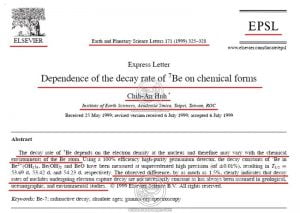
The dependence of the decay rate of the 7Be element on chemical forms; interestingly, the author also points out that these findings have the important differences with previous assumptions in the geological, oceanic and environmental domains that found the rate of radioactive decay as constant showing that, contrary to these assumptions, the rate of radioactive decay can be variable.
But another important point mentioned by the author of this paper is that some other elements such as 40K are also expected to occur and their different chemical forms are likely to decay with different rates. Interestingly, 40K is of high importance in various fields of geology and especially Radiometric dating (21):
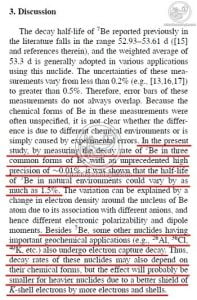
Radioactive decay rate change: Some of the radioactive elements used in geology include 26Al, 36Cl and especially 40K in different chemicals forms! This could disrupt the equations of the proponents of radiometric dating.
It may be assumed that only 1.5% of the difference due to different chemical forms is not a significant number and has little effect on the calculations of radiometric dating. But the fact is that the same amount of difference is also important in terms of geology and paleontology. For example, the radioactive element of 40K, which is among the most widely used radioactive atoms in the fields of geology, paleontology and paleontology, has a half-life of about 1.28 billion years (22). If we take even 1.5% of the time difference between the different chemical forms of 40K, that difference would be about 19 million and 200 thousand years! That is, a fossil that really and truly dates back 100 years would be mistakenly attributed to 19 million and 200000 years ago!!!
So, given that in radiometric dating calculations, this rate variability is not accounted for by different chemical forms, the numbers actually listed around the fossil lifetime is invalid and inaccurate, and it seems like all the numbers mentioned about the life of the fossils have to be seriously reviewed. For example, the dinosaur fossil of Anasazisaurus dating back to 74 million years ago (23), which is based on radiometric methods, may have actually and truly been 93 million years old or 55 million years ago. And given these great changes in radiometric dating calculations of other fossils of other species, what the proponents of the hypothesis of evolution regarded as intermediate fossils or fossil sequences was only fanciful!
So far, only the effects of different chemical forms of a radioactive element on its decay have been talked about, while other important factors have been record that will give rise to more questionable signals against radiometric dating!
- B) Lin-Gun Liu and Chih-An Huh from the Institute of Academia Sinica in Taiwan, in their paper titled Effect of pressure on the decay rate of 7Be, published in 2000 in the Earth and Planetary Science Letters (EPSL) journal, and and it is now readable through the well-known ScienceDirect system of (ELSEVIER) scientific publication, which states according to studies by the Institute, it has been observed that, contrary to earlier assumptions, the radioactive decay rate of 7Be is not independent of environmental factors and the rate of 7Be Radioactive decay increases with increasing pressure!!! (24).
Interestingly, the author of the paper explicitly points out that the radioactive decay constant (λ) of 7Be increases by about 1% at a pressure increase of 400 kbar! (25)
But most importantly, the author himself points out that due to the widespread use of the radiometric dating method based on the radioactive element of 40K and the possible influence of pressure changes on radioactive decay rate of 40K, possibly the geological and paleontological lifetime of the materials calculated to date, has not been accurate and the calculated lifetime is over estimated!!!(26):
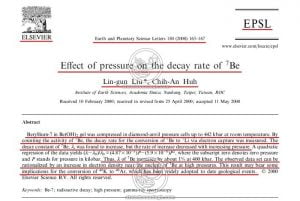
Effect of pressure on decay rate of 7Be: The author points out that the nuclear Radioactive decay rate increases by about 1% in exchange for increasing pressure to 400 kbar! But the important point is that the authors of the paper note that this finding may be generalizable to the conversion of 40K to 40Ar, which is widely used in geology (The decay rate of the radioactive element of 40K is also not independent of environmental factors, but is influenced by the environmental factor of pressure change).
Also, the authors of the paper, in the Results and Discussion section of the paper, explicitly point out that, if similar behavior occurs in the process of radioactive decay of the 40K, as the effect of pressure on the rate of radioactive decay of 7Be, the lifetimes calculated by the radiometric dating method based on the radioactive element of 40K are inaccurate and overestimated (27):
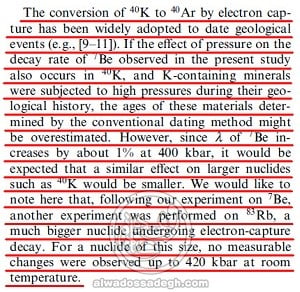
Also, the authors of the paper, in the Results and Discussion section of the paper, explicitly point out that, if similar behavior occurs in the process of radioactive decay of the 40K, as the effect of pressure on the rate of radioactive decay of 7Be, the lifetimes calculated by the radiometric dating method based on the radioactive element of 40K are inaccurate and overestimated. The lifetimes calculated by the Potassium 40: 40 K radioactive element based on the radiometric dating method, which have so far been calculated based on previous information, have been inaccurate and overestimated. Of course, the authors of the paper have pointed out that as the atomic mass of radioactive elements increases, the effect of pressure on the rate of radioactive decay decreases, as observed for the radioactive element of 83Rb until pressure about=420 kbar, there is no significant change in the radioactive decay rate of this element (Although the compressive effects above 420 kbar have not been studied for 83Rb, and at higher pressures, significant changes in the rate of radioactive decay of 83 Rb also occurs and, like lighter radioactive elements, changes in decay rate occurs).
Of course, as described in the caption above, the authors of the paper have pointed out that with increasing atomic mass of radioactive elements, the effect of pressure on the rate of radioactive decay decreases, as in the case of the radioactive element of 83Rb, it observed that up to a pressure of about 420 Kbar, a significant change in the rate of radioactive decay of this element does not occur (Although the compressive effects above 420 kbar have not been studied for 83Rb, and at higher pressures, significant changes in the rate of radioactive decay of 83 Rb also occurs and, like lighter radioactive elements, changes in decay rate occurs).
However, it is important to note that studies of radiometric dating based on light radioactive elements such as 10Be and medium-weight radioactive elements such as 40K, are widely used in biology and paleontology research.
Proponents of the hypothesis of evolution, for example, has been estimated the lifetime ofthe so-called hominid fossil titled Australopithecus bahrelghazali based on the radiometric dating of 10Be (another beryllium isotopes) to be about 3.6 million years (29), while this figure is calculated, factors such as the effect of pressure on the rate of radioactive decay of 10Be (as well as other factors such as the effect of different chemical forms, sun activity, etc.) is not considered, and therefore the lifetime calculated in the case of Australopithecus bahrelghazali fossil is not reliable.
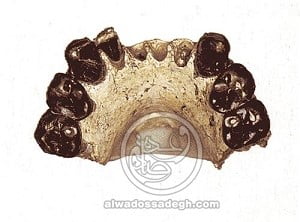
The fossil belongs to the Australopithecus bahrelghazali, which is estimated to be 3.6 million years old based on the radiometric dating of 10Be element. In the calculation, no attention has been paid to the effect of pressure, various chemical forms, etc. on the change in rate of the radioactive decay of 10Be. So the calculation seems to be inaccurate, simplistic and far from reality.
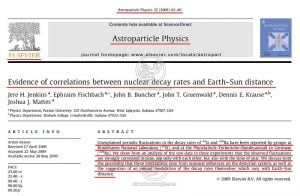
- C) Jere H. Jenkins, Ephraim Fischbach, John B. Buncher, John T. Gruenwald, Dennis E. Krause and Joshua J. Mattes from Purdue and Wabash Universities in Indiana, in their paper titled Evidence of correlations between Radioactive decay rates and Earth–Sun distance, published in 2009 in the valid Journal of Astroppaper Physics, and it is now readable through the well-known ScienceDirect system of (ELSEVIER) scientific publication, which states according to studies, it has been observed that the rate of the radioactive decay of 32Si and 226Ra, as previously thought, are not constant and change with seasonal changes as well as changes in the Earth-Sun distance!!!(30)
Evidence of relationship between radioactive decay rate with Earth-Sun distance; radioactive decay rate of radioactive elements of 32Si and 226Ra was not constant and unlike previous assumptions, and change with seasonal changes as well as changes in the Earth-Sun distance!!!
Note that due to the elliptical orbit around the sun, the distance between the earth and the sun varies from 147 to 152 million klm in different seasons, so that in January each year, there is a situation called Perihelion where the Earth is closest to the Sun (147 million klm), but in July of each year, there is a situation called Up Helion where the Earth is located farthest from the Sun (152 million klm) (31). According to the study, these minor changes are also affecting the rate of radioactive decay of the radioactive elements of 32Si and 226Ra (32).
Another important point to note is that the paper notes that in addition to changing the Earth-Sun distance, there are other possible mechanisms, such as the temperature changes of the different seasons can change the radioactive decay rate of radioactive elements of 32Si and 226Ra (33):
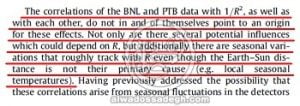
In addition to changing the Earth-Sun distance, other possible mechanisms, such as the temperature changes of different seasons, can also changethe radioactive decay rate of radioactive elements of 32Si and 226Ra.
Further studies by Alburger et al. (1986), Siegert et al. 1998 (35) and Falkenberg (36) in 2001, have also noted changes in the rate of radioactive decay of radioactive elements of 32Si, 152Eu and 3H, respectively, during the different seasons (37).
However, another study published by Norman et al. (2009) noted that some other radioactive elements such as 22Na, 44Ti, 108Agm, 121Snm, 133Ba, and 241Am, with have not showed the changes in radioactive decay rates that are proportional to Earth-Sun distance changes (38).
However, no major study has yet been done on whether or not the influence of the Earth-Sun distance and the seasonal changes in the rate change in the radioactive decay of important radioactive elements used in geology and biology such as 238U, 235U, 232Th, 40K, 87 Rb, 147Sm , 10Be, and 14C, but there have been significant changes in the rate of radioactive decay reported on some radioactive elements, including light, semi-heavy and heavy radioactive elements including 32Si, 152Eu, 3H and 226Ra in old and new studies, the most recent of which is 2009 (39), strongly have suggest the probability of seasonal changes as well as changes associated with the change in the Earth-Sun distance in the major radioactive elements studied in geology such as 238U, 40K, 10Be, and 14C!
Interestingly, however, in calculations related to the radiometric dating method, the probability of such fluctuations for the radioactive decay rate of the radioactive elements used is not taken into account, and therefore, the calculated fossil lifetimes based on the radiometric dating method is faced with many drawbacks, ambiguities and questions!
From this perspective, therefore, it appears that due to the lack of consideration of the effects of seasonal changes and the Earth-Sun distance changes on the rate of change of the radioactive decay rate of the radioactive elements studied in geology, the calculated numbers over the fossil lifetime are again inaccurate, optimistic, and inaccurate, and should be treated with suspicion.
- D) Jere H. Jenkins and Ephraim Fischbach from Purdue University (USA) in their paper entitled Perturbation of radioactive decay rates during the solar flare of 2006 December 13published in 2009 in the valid Journal of Astroppaper Physics and it is now readable through the well-known ScienceDirect system of (ELSEVIER) scientific publication, which states according to studies, it has been observed that the rate of the radioactive decay of the radioactive element of 54Mn, as previously thought, was not constant and changes with the appearance of solar flares!!! (40)

Perturbation in radioactive decay rates during (concurrent with) solar flares of 2006 December 13L Radioactive decay rate of 54Mn, as previously thought, was not constant and changes during solar flares!!!
These findings have been supported by other prominent physicists, such as Peter Sturrock of Standford University (41).
Interestingly, the authors of this paper, at the end of their paper, explained that the observed fluctuations in the rate of radioactive decay of the radioactive element of 54Mn occur during solar flares, is not a result of calculational and technical flaws, but a real change from the activities of the sun, including the emergence of solar flares (42). The authors of the paper have warned their opponents and potential critics that if they disagree with their findings, they could evaluate the rate change of the radioactive decay of radioactive element of 54Mn or other elements in emergence of the coming solar flares (43):
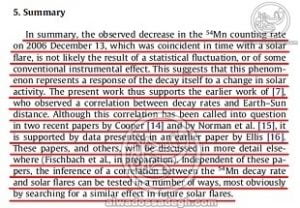
The fluctuations observed in the radioactive decay rate of the radioactive element of 54Mn during the solar flares emergence, not a result of calculational and technical flaws, but a real change from the activities of the sun, including the emergence of solar flares! The authors of the paper have warned their opponents and potential critics that if they disagree with their findings, they could evaluate the rate change of the radioactive decay of radioactive element of 54Mn or other elements in emergence of the coming solar flares!!!
Thus, as you can see, even the environmental factor changes in the activity of the sun can change the rate of radioactive decay!!! This is in direct contradiction to the assumptions and claims of geological and biologic scientists who regard radioactive decay as completely independent of environmental factors and consider the rate of radioactive decay to be constant.
The few important papers mentioned above are only part of the available documentation on the influence of environmental factors on the rate of radioactive decay. There are also other studies in this field that we devote more research to in this respectable audience.
But what is the result by knowing that environmental factors are changing the rate of radioactive decay?
Scientists favoring the use of the radiometric dating method, assuming that the radioactive decay rate of each element is constant and independent of environmental factors, consider the following diagram for each element’s radioactive decay:
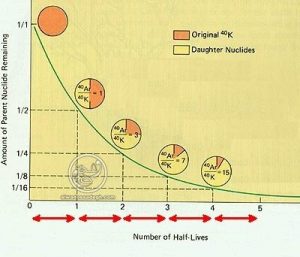
What proponents of radiometric dating method think about using it for studying fossils: Proponents of the radiometric dating method suggest that the radioactive decay rate of each element was constant and is independent of environmental factors. By this assumption, (t½) of a radioactive element during the radioactive decay reaction, remains constant, and because of this same constant half-life, using mathematical equations, the lifetime of the sample containing the desired radioactive material can be easily calculated (Red arrows with equal length are half-lives, which are always the constant, according to the assumptions and claims of the proponents of radiometric dating method).
But as proven in previous sections with documentation, we found that based on numerous, robust and concise studies, and exactly contrary to the proponents of using the radiometric dating method, no rate radioactive decay of radioactive elements and Half-lifetime of these radioactive elements are not constant, uniform and independent of environmental factors!!! Rather, according to the validresearch, various environmental factors such as different chemical forms, changing environmental pressure, changing the distance between the earth and the sun and even reducing or increasing the activity of solar flares on the surface also change the rate of radioactive decay of radioactive elements and (t½)!!! (44). And the interesting thing is that given the newness of many of these discoveries, there are probably other environmental factors that also alter the rate of radioactive decay and half-life, but have not yet been record and probably in the not too distant future, we will see a long list of factors that change the rate of radioactive decay!
But the situation becomes more complicated when we consider the simultaneous effect of several environmental factors on the rate of radioactive decay of radioactive elements and (t½)! Consider, for example, a dinosaur corpse called Anasazisaurus (45) buried 73 million years ago in a Be-rich environment and buried in mud layers over time. Then, about 65 million years ago, there were massive volumes of solar flares. Then, and again about 30 million years ago, another volume of solar flares were activated at various times, and with over time and further burial of this dinosaur, the pressure on the dinosaur fossil layer increased to about 400 kb and even more so. This change in environmental conditions, as well as changes in fossil pressures at different times, according to what you have seen in the previous sections, will cause a change in the rate of radioactive decay of the radioactive elements in the fossil and its surrounding layers:
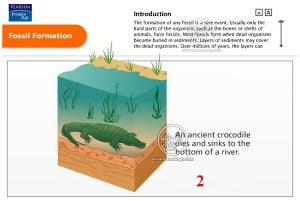
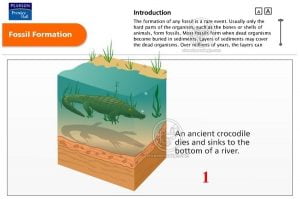
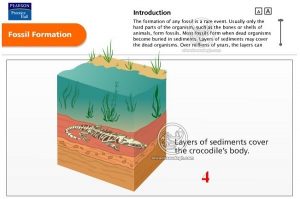
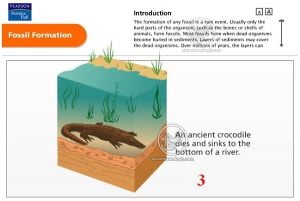
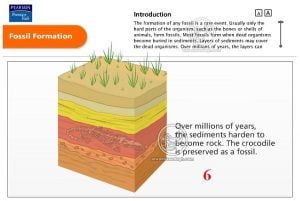
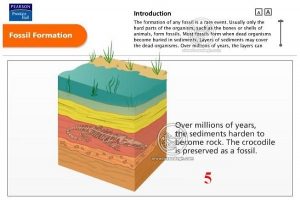
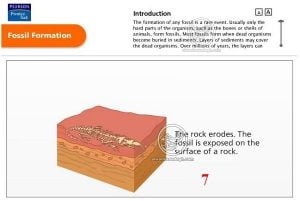
Stages of fossil formation: Consider the changes in environmental conditions and pressures over time and the effect of these pressures on the radioactive decay of radioactive elements in the fossil and its surroundings.
Now if we were to scientifically and precisely address the phenomenon of radioactive decay of the radioactive elements contained in such fossils. We have to keep in mind that given the important discoveries made and the numerous and unpredictable changes in the environmental conditions of fossils, such as chemical forms of change, various atmospheric pressures and the layers of top geology, the change of the Earth-Sun distance, the occurrence of multiple solar flares, and hundreds of other unrecorded changes over the last several million years, the rate of radioactive decay of the radioactive elements in the fossils themselves or their adjacent layers are not constant and unaltered and (t½) of the above mentioned elements has not been the constant.
In other words, the process of radioactive decay of radioactive elements in fossils will have a similar pattern:
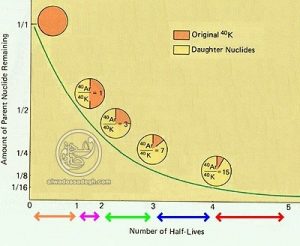
What is happening in the fossil samples in the real world and in nature: Given that the process of radioactive decay is influenced by various factors such as different chemical forms, changing environmental pressure, changing the Earth-Sun distance and even reducing or increasing the activity of solar flares on the surface of the Sun, and so on, the rate of radioactive decay of radioactive elements has been changed by these and other factors. In other words, (t½) time of radioactive elements is not the constant!!! (Contrary to my previous imagination!)). In the image above, the colored arrows (orange, purple, green, blue, and red) show the (t½) of the radioactive element studied at various times. According to new discoveries, this half-life varies according to different environmental conditions. For example, in the range indicated by the purple flash, due to the intense pressure on the fossil sample, the change in solar flares activity at that point in time, and the radioactive decay process intensified and accelerated, and therefore the half-lifetime is reduced. But in the range shown in red, due to the reducing environmental pressure, reverse change of solar flares activity, and so on, the radioactive decay process has slowed down and therefore half-life has increased! Given these changes in the rate of radioactive decay due to environmental factors, and given that we do not have a good understanding of what happened in the fossil formation environment,
(for example, we do not know over the last 40 million years, whether the fossil and its surrounding layers have been able to withstand the pressure, have passed several solar flares, or so on), we have virtually no knowledge of the changes made in the rate of radioactive decay and the half-life changes over time and we have to admit that the use of the radiometric dating method for paleontological studies and fossil lifetime determination is inaccurate, unreliable and inappropriate!!!
According to the above, given that we do not have accurate knowledge of the environmental conditions of fossils, including the amount of pressure exerted on them, solar flare activity and so on over the past several million years, we practically don’t know the changes of the radioactive decay rate applied during this time either, so the use of the radiometric dating method to study fossil lifetime would be inaccurate and useless!
2) In addition to the remarks about radioactive decay, there are other factors that challenge the radiometric dating reliance or at least they face ambiguities and drawbacks!
For example, as mentioned in earlier sections of this paper, there is an important assumption in the method of radiometric dating that it is assumed that in the elementary time (zero hour), there is no daughter ducleus and all samples only include parent nucleus. This assumption can be true in vitro and under the control of scientists who want to work on a pure radioactive material, but in the case of biology and geology samples, there is no assurance that this assumption is true in outside the environment and in the natural environment.
For example the reaction of the conversion of the radioactive element of 10Be to 9Be used in some geological and biological studies (including the study of the fossil lifetime of Australopithecus bahrelghazali) (46), there is no assurance that at the early time (zero hour), all samples consisted solely of 10Be and lacking beryllium 9Be. Because by air, groundwater, etc., at the same initial time as the fossil was formed, significant amounts of 9Be were introduced into the studied sample, and therefore, it affects our current calculations!
3) Another point that makes the radiometric dating method inaccurate is that studies based on the radiometric dating method are mainly discussed in closed systems, because it is closed system that the concentration and concentration ratio of parent nucleus and Daughter Nucleus are solely dependent on radioactive decay and the ratio between parent and daughter nucleus was determined by the conversion resulting from the radioactive decay of the parent nucleus into the daughter nucleus determines. But when the system is not a closed system and the radioactive particles can be added from the outside of the environment, or the radioactive particles are removed from the environment in a way other than radioactive decay, studies based on radiometric dating won’t be usable.
In nature, the samples studied are not located in closed systems and are located in open systems. For example, 14C is produced by the collision of cosmic radiation with the atmosphere followed by a chain of physico-chemical reactions (47) and the concentration of 10Be in the atmosphere is also associated with cosmic radiation (48). Due to continuous production and, albeit at varying concentrations at different times, many of these created radioactive elements can be incorporated into fossil-forming or fossil-containing samples and cause serious calculational bugs by closed system violations.
4) On the other hand, all the bugs mentioned above are related to physical events affecting radioactive decay and radiometric dating. However, in addition to physical radioactive decay, there are other methods and reasons that can cause changes in the concentrations of parent nucleus and Daughter Nucleus in the sample studied, and calculations based on the radiometric dating method completely distorted!
For example, chemical reactions and chemical processes can also affect the concentrations of parent nucleus and Daughter Nucleus and, in addition to the radioactive decay process, as a side effects cause changes in the concentrations of parent nucleus and daughter nucleus, thereby overriding calculations based on the radiometric dating method, causing improper and inaccurate lifetime calculations about fossils lifetime!
For example, suppose the corpse of an animal that is dead on the bed of a river, and it has covered by 1.5 m layer of mud after 10000 years. However, if water penetration into the buried corpse continues, part of the parent nucleus can be leached from the fossil and surrounding environment and dissolved in water if it is soluble in water, entering the groundwater or current water and move away from the fossil and surrounding area! In this case, then, only the radioactive decay process will not cause the parent nucleus concentration to drop, and a very important factor called Dissolution in Water can also reduce the concentration of radioactive material! However, the reduction in the concentration of parent nucleus is not just confined to the radioactive decay process and, in addition, is affected by the dissolution process, which also causes disruptions in all calculations based on the radiometric dating method:
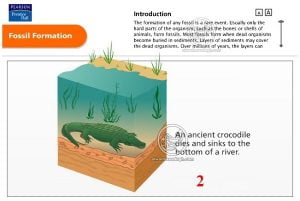
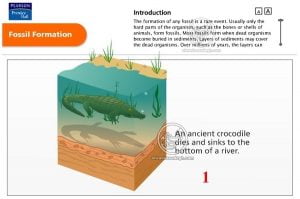
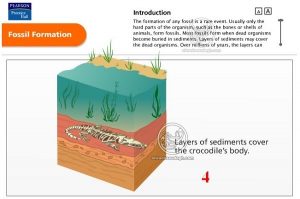
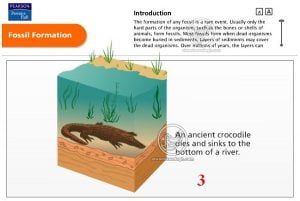
The radioactive elements in fossils that are found in wet and humid environments or the radioactive elements surrounding these fossils may be affected by the process of dissolution in addition to the radioactive decay process! The dissolution process also results in the dissolution of the parent nucleus and by dissolving and washing these nucleus, it reduces further and disproportionately to its radioactive decay process! In this way, the dissolution process, by disproportionately reducing the parent nucleus, causes calculational disruption and disrupts all equations related to the radiometric dating method and invalidates the results!
Of course, the discussion of other disruption factors of the radiometric dating method is a long one and is out of the scope of this paper and we leave it to the respected audience for further study. However, as you have noted, the radiometric dating method is justified by many drawbacks, questions, ambiguities and inconsistencies, and there are many factors that can disrupt this approach and its associated achievements! In other words, contrary to the claims of evolutionists and proponents of the radiometric dating method, this method is not an accurate one, but a flawed one, relying on it to calculate of fossils lifetime is virtually impossible!
But are the flaws and drawbacks of the radiometric dating method only relevant to laboratory studies? Is there a practical example to prove this method to be inaccurate?
In short, it should be said no! The flaws and drawbacks of the radiometric dating method are not limited to laboratory studies and there are important practical examples to prove this method to be inaccurate!
The study of volcanic rock samples that have been active for the last several centuries reveals major contradictions between the actual time of formation of these rocks and the time calculated by the radiometric dating method!
Dr. G. Brent. Dalrymple, from Stanford University in his book titled Age of the Earth, is compared to actual lifetime and life calculated by the radiometric dating method in igneous (volcanic) rocks of some famous volcanoes (49):
|
Studied area | Actual lifetime (based on direct observations or strong historical documentation) | Lifetime calculated by radiometric dating method based on 40K to 40Ar conversion reaction |
| Hualalei, Hawaii | 1801 (211 years) | 1100000 years (one million one hundred thousand years)?!!! |
| Sunset Crater, Arizona | 1605 (947 years) | 200000 years (two hundred thousand years)?!!! |
| Mt. Etna, Sicely | 1792 (220 years) | 150000 years (one hundred and fifty thousand years)?!!! |
As you noted, there are significant differences between the actual lifetime of the rocks and the lifetime calculated by the radiometric dating method! So until the time difference is about 1100000 (one million and one hundred thousand years)?!!! also seen between these times!!!
Dr. G. Brent. Dalrymple, who is a proponent of radiometric dating and its use in geological studies, for justification of these great errors of calculation by radiometric dating says that the cause of the miscalculation in these samples is the presence of impurities called xenoliths in the samples (50)! Xenoliths are impure rock particles found in the core of the magma, and because of having excess argon in their cores, causes the miscalculation of their lifetime (51)!
This words of Dr. Brent Dalrymple and his supporters in this justification are not very acceptable, because:
1) First of all, the words of Dr. Dalrymple and his supporters, before trying to shut down the mouths of critics like us, support our claim in previoud paragraph!!! Because, as we mentioned in the previous few lines, one of the drawbacks of using radiometric dating in geology, paleontology and paleontology is that the samples studied in the sciences are not located in the closed systems and classified as open systems. However, as we have said, the use of the radiometric dating method is only acceptable in closed systems that don’t allow the entry and exit of parent and daughter nucleus!
This problem is based on the conversion of 40K to 40Ar due to the incorporation of xenoliths in the samples studied, based on the conversion of 40K to 40Ar, and other impurities, excess amounts of 40 Ar (which is the daughter nucleus of 40Ar → 40K reaction) introduced into the sample, cause calculational errors, exactly proves our point in the previous few paragraphs that due to the open systems in geology, paleontology and paleontology, and according to impurities entering the surronding environment to the sample, the radiometric dating method cannot be used as a reliable method for geological and paleontological studies !!! Thus, Dr. Dalrymple justifications seem to be the detriment of such studies, rather than in favor of the use of radiometric dating in geology and biology, and, moreover, proof of our claim!
2) Secondly, as Dr. Dalrymple et al. considered the xenoliths and other impurities as a factor in the calculational errors in studies of radiometric dating, they asked themselves what assurance was there that the samples studied in paleontology did not contain the same xenoliths particles?!!! For example, the lifetime of the dinosaur fossil, estimated to have been around igneous rocks around 65 million years, how is it known that this calculated lifetime has not been affected by the xenoliths associated with magma formation?!!! How is it known that the actual lifetime of the fossil was not 55 million years and that the inclusion of xenoliths incorrectly overestimated the actual life of the fossil?!!!
In fact, just as Dr. Dalrymple et al. today have termed xenoliths as calculational abnormalities, we can also generalize this to the past, and all the calculated lifetime of fossils are doubted because at the time of formation of the mentioned rocks, xenoliths have entered the samples!!!
3) Thirdly, it seems that Dr. Dalrymple et al. are ignored the effects of other environmental factors such as chemical variable forms, various atmospheric pressures and upper geological layers, the Earth-Sun distance, the incidence of multiple solar flares and etc. on the rate of radioactive decay record in scientific studies in recent decades (52) as well as hundreds of other covered agents and the great differences between the actual lifetimes of geological and paleontological samples with the lifetimes calculated using the radiometric dating was due only for existence of excess argon! However, as mentioned in the previous sections of the paper, even examples of other radioactive elements include 226Ra, 7Be, 32Si, 152Eu, 54Mn and 3H whose presence of excess argon does not affects their calculations related to radiometric dating. Again, we find that their radioactive decay rates are influenced by environmental factors such as variable chemical forms, various atmospheric pressures and upper geological layers, Earth-Sun distance change, numerous incidents of solar flares and so on (53)! So it seems that Dalrymple et al. justifications were too simplistic!
4) Fourthly, contrary to the claims of Dr. Dalrymple et al., who have cited only the above three cases and have identified them as exceptions due to impurities and xenoliths. Numerous other examples have been found in the real world and in nature and still showing very sharp differences between the actual time of formation of these samples and the time calculated by the radiometric dating method! The following examples illustrate a part of these contradictions (54):
|
Studies area | Actual lifetime (based on direct observations or strong historical documentation) | Lifetime calculated by radiometric dating method based on 40K to 40Ar conversion reaction |
Reference |
| (Akka Water Fall flow, Hawaii) | Pleistocene | About 32 million years?!!! | Krummenacher, 1970 |
| (Kilauea Iki basalt, Hawaii) | 1959 | About 8.5 million years?!!! | Krummenacher, 1970 |
| (Mt. Stromboli., Italy, volcanic bomb) | September 23, 1963 | About 2400000 years?!!! | Krummenacher, 1970 |
| (Mt. Etna basalt, Sicily) | May, 1964 | About 700000 years?!!! | Krummenacher, 1970 |
| (Medicine Lake Highlands obsidian, Glass Mountains, California) |
Less than 500 years |
About 12600000 years?!!! |
Krummenacher, 1970 |
| (Hualalai basalt, Hawaii) | 1800-1801 | About 22800000 years?!!! | Krummenacher, 1970 |
| (Ranigitoto basalt, Auckland, New Zealand) | Less than 800 years | About 150000 years?!!! | McDougall et al, 1969 |
| (Alkali basalt plug, Benne, Nigeria) | Less than 30 million years | About 95 million years?!!! | Fisher, 1971
|
|
Studies area | Actual lifetime (based on direct observations or strong historical documentation) | Lifetime calculated by radiometric dating method based on 40K to 40Ar conversion reaction |
Reference |
| Olivine basalt, Nathan Hills, Victoria Land, Antarctica |
Less than 300000 years |
About 18 million years?!!! |
Armstrong, 1978 |
| Anorthoclase in volcanic bomb, Mt. Erebus, Antarctica |
1984 |
About 640000 years?!!! |
Esser et al, 1979 |
| Kilauea basalt, Hawaii | Less than 200 years | About 21 million years?!!! | Noble and Naughton, 1968 |
| Kilauea basalt, Hawaii | Less than 1000 years | About 42900000 years?!!! | Dalrymple and Moore, 1968 |
| East Pacific Rise basalt | Less than 1 million years | About 690 million years?!!! | Funkhouser et al, 1968 |
| Seamount basalt, near East Pacific Rise | Less than 2500000 years | About 580 million years (calculated by Frank Hauser)?!!! About 700 million years (calculated by Fisher)?!!! | Funkhouser et al, 1968 Fisher, 1972 |
| East Pacific Rise basalt | Less than 600000 years | About 24200000 years?!!! | Dymond, 1970 |
| Andesite flows, Mt Ngauruhoe, New Zeland | 1949 and 1954 | From 270000 years to 3.5 million years?!!! (Great differences between samples)! | Snelling, 1998 |
With a bit of precision in the tables above, we find that contrary to the claims of radiometric dating, incorrect calculations in the geological and paleontological lifetime of the sample are very prevalent, and contrary of them, these false calculations are not just a few exceptions! In fact, the multitude of false and inaccurate calculations in calculating the lifetime of geological and paleontological samples, based on one of the most widely used radioactive decay reactions (40Ar → 40K reaction), shows that the relies on radiometric dating is not accurate enough to determine the lifetime of biology and geology samples!
In short, according to the material in the fourth part of the series of papers of Hypothesis of Evolution: The Forbidden Area! As noted, we find that contrary to the claims of the hypothesis of evolution, the lifetime and age of fossils, which were mainly calculated based on the radiometric dating method, are not accurate! Because the use of the radiometric dating method in calculating the fossil lifetime is based on assumptions that today have been largely disproved and questioned! Assumptions such as no effect of environmental factors on the time of radioactive decay, no entry of impurity to the studied samples, and so on are now facing serious challenges and the validity of these assumptions has been completely questioned!
In the practice field, studies of geological samples also show significant contradictions between the actual lifetime of the samples and the calculated lifetimes using the radiometric dating method! The calculating lifetime of 8.5 million years for a sample that is only 11 years old and calculating lifetime of 23 million years for a sample of 170 years is one of the masterpieces resulting from relying on the radiometric dating method!!! (55)
The contents of this paper show that the calculated times for many fossils are inaccurate and require serious revision of the calculations for these lifetimes (In some cases, because of the lack of knowledge about the effect of the environment several million years ago on radioactive decay, it is impossible to calculate it in the future at all!).
Given the inaccuracy of the lifetime of the fossil record, the fossil sequences presented by proponents of the hypothesis of evolution are practically different with the story of Alice in Wonderland! Because when the 20th-century geological sample is estimated to have a lifetime of 8.5 million years in the laboratory for radiometric dating. It is not unlikely that the fossil that was so long considered to be about 3.6 million years old would have actually been a 30000-year-old fossil! And vice versa, a sample that was considered to be 1.5 million years old would actually have a lifetime of 5 million years!!!
Given this concern, distortions and inaccuracies over the fossils calculated lifetimes to date, it does not appear that the part of the fossils that the hypothesis of evolution proponents would rely on, it is true in the real world and in nature too! Because the fossil that evolutionists claimed 10 million years ago is unlikely to actually be 10 million years old, and that 8 million year old fossil really is 8 million years old!!!
Due to great calculational errors in radiometric dating, that 8 million-year-old fossil may, in principle, have a life of 12 million years and the 10-million-year fossil claimed by proponents of the hypothesis of evolution is only 4 million years old in the real world!!! However, the earlier claims by evolutionists that their falsely calculated 10 million-year-old fossil was taken ancestor of their falsely calculated 8 million-year-old fossil was false and incorrect, completely!!!


It is what falsely calculations bring on the fossil sequence! The image on the left is one of those images that proponents of evolution organized by calculation based on the radiometric dating method used so far. Based on this type of calculations, the fossils are arranged according to the age they have calculated so that they can be used as evidence. Right image: Given the huge great contradictions and mistakes in radiometric dating (including an estimated lifetime of 8.5 million years for a sample that is only 11 years old!!!), it is very likely that the true lifetime of the fossils in question will vary greatly from what evolutionists claim! However, the time sequence of the fossils has changed and the evidence used by evolutionists is being questioned!!!
Answer to an doubt: In this part of our remarks, proponents of the hypothesis of evolution may come to us that even if there are calculational errors in calculating the fossil lifetime of a particular country or continent, examination of similar fossils of the same species of animal found in another country or continent can overcome calculational errors by averaging the ages calculated using the radiometric dating method, different fossils discovered from a single living species (eg dinosaurs) found on different continents can overcome calculational errors!
While this may be true in some cases, it is not true at all! Because firstly, multiplication of samples minimizes calculational errors but does not reduce them to zero. Secondly, this can only be true to a certain extent if the animal in question has multiple fossils found around the world. For example, the Tyrannosaurus rex, whose fossils have been abundantly record in various parts of the world (at least 30 fossils), (56) can prove the point of view of evolutionists. But it is interesting to know that many fossils record are not sufficiently numerous and have been found in only one or more numbers, and even in some cases only a small part of their skeletons (head or teeth or so on ) were record and unfortunately these same samples are the criterion for evaluation! For example, in the dinosaurs of Anasazisaurus and Nashviibitosaurus, there is only one fossil record, and not even a single fossil contains all the bones! (57) But interestingly, evolutionists, relying on these flawed samples, determine the lifetime and dating of these dinosaurs and provide storytelling about them.
Interestingly, this lack of information and the lack of fossils is more evident in fossils related to the sequence of human evolution! To the extent that many fossils attributed to the ancestors or relatives of modern humans have been record only at one point and at a single number, and evolutionists based on the radiometric dating of these single fossils, have hurriedly summed up and provide storytelling about them!!! Fossils such as Hominid called Australopithecus bahrelghazali, Kenyanthropus platyops, and so on. Or even only a small fraction of a fossil record (58) were recorded only one samples or even only a small portion of a fossil (58), and their explorers have calculated their lifetime only based on the same fossil sample!!! Other samples include Australopithecus sediba includes only two fossil samples! And interestingly, their explorers have used just these few samples for their calculations!!! As noted in the previous sections of this paper, the probability of error in calculating the lifetime of the fossil record is strongly high, and this for fossils containing only one or two samples is more than fossils containing several samples. Considering this, we will find that many of the fossils mentioned by evolutionists are also prone to calculational error due to being single-fossil or containing a small number of fossils.
A very important note: In addition to the radiometric dating method, which is used as the most commonly used method in the dating of geological, biological and paleontological samples, there are other dating methods that are less important, reliable, and accurate than radiometric dating. For example, the amino acid dating method is also a dating method which is foremd based on calculating the D- and L-amino acid ratios in fossil protein samples, and is organized based on the ratio between these two types of optical isomers of amino acids, assuming that, after living death, over time, some of the L-amino acids isomers will gradually become type D (60). In this paper, we do not address on the amino acid dating in detail because it is not accurate and reliable and is not widely used in scientific communities (61). The reason for this is that the rate of conversion of L-amino acid isomers to the D-amino acid isomers after death is influenced by environmental factors such as temperature, concentration of water in the environment, pH, amount of binding, macromolecule size, macromolecule specific site, soil contact, presence of aldehydes, buffer concentration and environment ionic strength (62). Given the uncertainty of these environmental factors over the millions of years ago on the studied sample, it is virtually impossible to use the amino acid dating method to determine the fossil lifetime. Even better, this method is less accurate than the radiometric dating method! For this reason, the amino acid dating method is of little use in calculating the fossil lifetime (63) and we therefore overlook its detailed critique.
Very important note: Among christian proponent of creationism, there is the idea of Young Earth called Young Earth Creationism (YEC) (64), and a number of biologists and geologists oppose the hypothesis of evolution are the proponent of YEC. According to the YEC theory, the lifetime of the earth is between 5700 and 10,000 years, according to the teachings of the Jews and Christians (65).
In this section of the paper, we note that we disagree with this view and believe that, according to the verses and traditions, no definite number can be obtained over the lifetime of the earth (66). They refer to the long life of the earth (67). God willing, we extend this discussion to the final sections of this series of papers.
At the end of this section of the paper, we note again that due to the inconsistencies, errors, and inaccuracies in the calculations of fossil lifetimes, which are also largely based on studies based on unreliable methods of the radiometric dating, even the fossils lifetime claimed by proponents of the hypothesis of evolution face serious challenges and ambiguities. For this reason, we cannot trust the time attributed to the fossils record. This poses a big problem in accepting fossils as a reliable witness in evolutionary studies! According to the latest studies, even the times assigned to these fossils are not reliable!!! So this is a huge obstacle to the proponents’ claim to the hypothesis of evolution and acceptance of their opinions about fossil record!
In the end, again, it’s not all of our arguments to refute the hypothesis of evolution proponents around fossils! Rather, this section of the paper is the first section of the evolutionists’ critiqueabout fossils! God willing, in the next five or six sections of this series of papers, we will continue our scientific critique of the fossil record of the hypothesis of evolution about fossils. And after finishing the paleontology sections, we will criticize and refute evolutionists’ claims in other areas of biology, including topics related to cellular and molecular biology. We ask God Almighty to help us continue on the path.
Hoping that the spurious greatness of the oppressors be destroyed as soon as possible.
Hoping for the coming saviour messenger, al-Mahdi
Writted by: Servant of al-Mahdi– September 2012
![]()


